
laser_measurement_instruments_catalog
.pdf
Sensor |
|
Features |
|
Aperture |
|
Spectral Range |
|
Power Range |
|
Energy Range |
|
Page |
L50(150)A-LP1-35 |
|
CW to 50W, intermittent to 150W high damage |
|
Ø35mm |
|
0.25-2.2μm |
|
100mW-150W |
|
40mJ-300J |
|
32 |
|
|
threshold for long pulses |
|
|
|
|
|
|
|
|
|
|
L50(150)A-PF-35 |
|
CW to 50W, intermittent to 150W for short pulse lasers |
|
Ø35mm |
|
0.15-20μm |
|
100mW-150W |
|
50mJ-300J |
|
32 |
30(150)A-SV-17 |
|
Very high damage threshold, 30W |
|
Ø17mm |
|
0.19-12μm |
|
100mW-150W |
|
50mJ-300J |
|
33 |
|
|
continuous 150W intermittent |
|
|
|
|
|
|
|
|
|
|
30(150)A-HE-17 |
|
High energy and average power YAGs and harmonics |
|
Ø17mm |
|
0.19-0.625μm, |
|
50mW-150W |
|
60mJ-200J |
|
33 |
|
|
30W continuous 150W intermittent |
|
|
|
1.064μm, |
|
|
|
|
|
|
|
|
|
|
|
|
2.1μm, 2.94μm |
|
|
|
|
|
|
30(150)A-HE-DIF-17 |
|
For highly concentrated Q switched pulses to 30W, |
|
Ø17mm |
|
0.19-3μm except for |
|
50mW-150W |
|
60mJ-200J |
|
33 |
|
|
intermittent to 150W |
|
|
|
625-900nm |
|
|
|
|
|
|
20C-SH |
|
Compact smart sensor |
|
Ø12mm |
|
0.19-20μm |
|
10mW-20W |
|
6mJ-10J |
|
34 |
L30C-SH |
|
Medium aperture, smart sensor |
|
Ø26mm |
|
0.19-20μm |
|
80mW-50W |
|
30mJ-30J |
|
34 |
100C-SH |
|
Low profile, smart sensor |
|
Ø18mm |
|
0.19-20μm |
|
60mW-100W |
|
N.A |
|
34 |
150C-SH |
|
High power, smart sensor |
|
Ø18mm |
|
0.19-20μm |
|
60mW-60W |
|
20mJ-100J |
|
34 |
150W-SH |
|
High power, water cooled smart sensor |
|
Ø18mm |
|
0.19-20μm |
|
60mW-150W |
|
20mJ-100J |
34 |
|
Medium power thermal sensors - apertures 50 to 65mm, 100mW - 300W
Sensor |
|
Features |
|
Aperture |
|
Spectral Range |
|
Power Range |
|
Energy Range |
|
Page |
L40(150)A |
|
CW to 35W, intermittent to 150W, large aperture |
|
Ø50mm |
|
0.19-20μm |
|
100mW-150W |
|
100mJ-200J |
|
35 |
L40(150)A-LP1 |
|
As above, high damage threshold for long pulses |
|
Ø50mm |
|
0.25-2.2μm, 2.94μm |
|
100mW-150W |
|
100mJ-300J |
|
35 |
L40(150)A-EX |
|
As above for excimer lasers |
|
Ø50mm |
|
0.15-0.7μm, 10.6μm |
|
100mW-150W |
|
100mJ-200J |
|
35 |
L50(150)A |
|
CW to 50W, intermittent to 150W |
|
Ø50mm |
|
0.19-20μm |
|
100mW-150W |
|
100mJ-300J |
|
35 |
L50(300)A |
|
CW to 50W, intermittent to 300W, very large aperture |
|
Ø65mm |
|
0.19-20μm |
|
400mW-300W |
|
200mJ-300J |
|
36 |
L50(300)A-LP1 |
|
As above, high damage threshold for CW and long pulses |
|
Ø65mm |
|
0.25-2.2μm |
|
400mW-300W |
|
200mJ-300J |
|
36 |
L50(300)A-PF-65 |
|
CW to 50W, intermittent to 300W, large beam short pulses |
|
Ø65mm |
|
0.15-20μm |
|
400mW-300W |
|
200mJ-300J |
|
36 |
L50(300)A-IPL |
|
For gel coupled IPL sources |
|
Ø65mm |
|
0.5-1.1μm |
|
400mW-300W |
|
120mJ-300J |
|
36 |
Medium-high power fan cooled thermal sensors – 50mW – 500W
Sensor |
|
Features |
|
Aperture |
|
Spectral Range |
|
Power Range |
|
Energy Range |
|
Page |
F100A-PF-DIF-33 |
|
High average power, short pulse lasers |
|
Ø33mm |
|
0.24-2.2μm |
|
50mW-100W |
|
60mJ-200J |
|
37 |
F150A-BB-26 |
|
Fan cooled to 150W |
|
Ø26mm |
|
0.19-20μm |
|
50mW-150W |
|
20mJ-100J |
|
37 |
FL250A-BB-35 |
|
Fan cooled to 250W |
|
Ø35mm |
|
0.19-20μm |
|
150mW-250W |
|
50mJ-300J |
|
37 |
FL250A-LP1-35 |
|
As above, high damage threshold for long pulses and CW |
|
Ø35mm |
|
0.25-2.2μm |
|
150mW-250W |
|
50mJ-300J |
|
37 |
FL250A-LP1-DIF-33 |
|
Fan cooled to 250W with diffuser for high power and |
|
Ø33mm |
|
0.4-3μm |
|
400mW-250W |
|
400mJ-600J |
|
37 |
|
|
energy density |
|
|
|
|
|
|
|
|
|
|
FL250A-BB-50 |
|
Fan cooled to 250W, large aperture |
|
Ø50mm |
|
0.19-20μm |
|
150mW-250W |
|
80mJ-300J |
|
38 |
FL400A-BB-50 |
|
Fan cooled to 400W |
|
Ø50mm |
|
0.19-20μm |
|
300mW-400W |
|
75mJ-600J |
|
38 |
FL400A-LP1-50 |
|
Fan cooled to 400W, high power densities and long pulses |
|
Ø50mm |
|
0.35-2.2μm, 10.6μm |
|
300mW-400W |
|
75mJ-600J |
|
38 |
FL500A |
|
Fan cooled to 500W, very large aperture |
|
Ø65mm |
|
0.19-20μm |
|
500mW-500W |
|
100mJ-600J |
|
38 |
FL500A-LP1 |
|
Fan cooled to 500W, high power densities and long pulses |
|
Ø65mm |
|
0.25-2.2μm |
|
500mW-500W |
|
100mJ-600J |
|
38 |
High power water cooled thermal sensors - 1W – 10kW
Sensor |
|
Features |
|
Aperture |
|
Spectral Range |
|
Power Range |
|
Energy Range |
|
Page |
L250W |
|
Thin profile, 20mm thick, water cooled to 250W |
|
Ø50mm |
|
0.19-20μm |
|
1W-250W |
|
120mJ-200J |
|
40 |
L300W-LP1-50 |
|
Thin profile, 20mm thick, water cooled to 300W |
|
Ø50mm |
|
0.35-2.2μm, 10.6μm |
|
4W-300W |
|
200mJ-300mJ |
|
40 |
1000W-BB-34 |
|
Water cooled to 1000W |
|
Ø34mm |
|
0.19-20μm |
|
5W-1000W |
|
300mJ-300J |
|
41 |
1000W-LP1-34 |
|
Water cooled to 1000W, high power densities and long pulses |
|
Ø34mm |
|
0.35-2.2μm, 10.6μm |
|
5W-1000W |
|
400mJ-300J |
|
41 |
L1500W-BB-50 |
|
Water cooled to 1500W |
|
Ø50mm |
|
0.19-20μm |
|
15W-1500W |
|
500mJ-200J |
|
41 |
L1500W-LP1-50 |
|
As above, high power densities and long pulses |
|
Ø50mm |
|
0.35-2.2μm, 10.6μm |
|
15W-1500W |
|
500mJ-200J |
|
41 |
5000W-BB-50 |
|
Water cooled to 5000W |
|
Ø50mm |
|
0.19-20μm |
|
20W-5000W |
|
N.A. |
|
42 |
5000W-LP-50 |
|
As above, high power densities and long pulses |
|
Ø50mm |
|
0.4-1.5μm, 10.6μm |
|
20W-5000W |
|
N.A. |
|
42 |
10K-W-BB-45 |
|
Water cooled to 10,000W, very high power densities |
|
Ø45mm |
|
0.8-2μm, 10.6μm |
|
100W-10KW |
|
N.A. |
|
42 |
5000W / 10K-W |
|
Housing with shutter to protect 5000W and 10K-W |
|
Ø52mm |
|
N.A. |
|
N.A. |
|
N.A. |
|
43 |
Protective Housing |
|
sensors from contamination by debris |
|
|
|
|
|
|
|
|
|
|
with Shutter |
|
|
|
|
|
|
|
|
|
|
|
|
Very high power water cooled thermal sensors 100W – 100kW
Sensor |
|
Features |
|
Aperture |
|
Spectral Range |
|
Power Range |
|
Energy Range |
|
Page |
|
|
|
|
|
|
|
|
|
|
|
|
|
30K-W-BB-74 |
|
Water cooled to 30,000W, high power densities |
|
Ø74mm |
|
0.8-2μm, 10.6μm |
|
100W-30kW |
|
N.A. |
44 |
|
100K-W |
|
Water cooled to 100,000W. Highest powers |
|
Ø200mm |
|
0.8-1.1μm |
|
10kW-100kW |
|
N.A. |
|
45 |
1.0 Sensors
9
For latest updates please visit our website: www.ophiropt.com/photonics |
01.04.2014 |

1.0 Sensors
Power pucks 20W – 10kW
Sensor |
|
Features |
|
Aperture |
|
Spectral Range |
|
Power Range |
|
Energy Range |
|
Page |
|
|
|
|
|
|
|
|
|
|
|
|
|
|
|
Comet 1K |
|
Portable low-cost power probe with low powers |
|
Ø50mm |
|
0.2-20μm |
|
20W-1000W |
|
N.A. |
46 |
|
|
Comet 10K |
|
Portable low-cost power probe with high powers |
|
Ø100mm |
|
1.06μm and 10.6μm |
|
200W-10,000W |
|
N.A. |
|
46 |
|
Comet 10K-HD |
|
Portable low-cost power probe with high damage |
|
Ø55mm |
|
1.06μm and 10.6μm |
|
200W-10,000W |
|
N.A. |
46 |
|
|
|
|
threshold |
|
|
|
|
|
|
|
|
|
|
|
Beam dumps up to 10kW
Sensor |
Features |
Aperture |
Spectral Range |
Power Range |
Energy Range |
Page |
|
|
|
|
|
|
|
|
|
|
|
BDFL500A-BB-50 |
fan cooled beam dump up to 500W |
Ø50mm |
0.19-20μm |
up to 500W |
N.A. |
47 |
|
|
|
|
|
|
|
|
|
|
|
BD5000W-BB-50 |
Water cooled beam dump up to 5000W |
Ø50mm |
0.19-20μm |
up to 5000W |
N.A. |
47 |
|
|
|
|
|
|
|
|
|
|
|
BD10K-W |
Water cooled beam dump up to 10,000W |
Ø45mm |
0.19-20μm |
up to 10,000W |
N.A. |
47 |
|
|
|
|
|
|
|
|
|
|
|
BeamTrack – Power / Position / Size Sensors
Sensor |
|
Features |
|
Aperture |
|
Spectral Range |
|
Power Range |
|
Energy Range |
|
Page |
|
|
3A-QUAD |
|
Power & position, very low powers up to 3W |
|
Ø9.5mm |
|
0.19-20μm |
|
100µW-3W |
|
20µJ-2J |
|
49 |
|
|
3A-P-QUAD |
|
As above for short pulse lasers |
|
Ø12mm |
|
0.15-8μm |
|
160µW-3W |
|
30µJ-2J |
|
49 |
|
|
10A - PPS |
|
Power, position & size to 10W |
|
Ø16mm |
|
0.19-20μm |
|
20mW-10W |
|
6mJ-2J |
|
49 |
|
|
50(150)A-BB-26-PPS |
|
Power, position & size to 50W, 150W intermittent |
|
Ø26mm |
|
0.19-20μm |
|
40mW-150W |
|
20mJ-100J |
|
50 |
|
|
F150A-BB-26-PPS |
|
Power, position & size to 150W |
|
Ø26mm |
|
0.19-20μm |
|
50mW-150W |
|
20mJ-100J |
|
50 |
|
|
FL250A-BB-50-PPS |
|
Power, position & size to 250W, large aperture |
|
Ø50mm |
|
0.19-20μm |
|
150mW-250W |
|
80mJ-300J |
51 |
|
|
|
1000W-BB-34-QUAD |
|
Power & position, high powers up to 1000W |
|
Ø34mm |
|
0.19-20μm |
|
5W-1000W |
|
500mJ-300J |
51 |
|
|
|
Power Sensor Accessories
Accessories for PD300 sensors
Fiberoptic adapters |
|
|
|
|
|
Accessory |
|
Description |
|
Page |
|
PD300 F.O. adapters |
|
Adapters for mounting fibers to PD300 sensors (ST, FC, SMA, SC) |
|
54 |
|
PD300-CDRH |
|
φ7mm aperture adapter for CDRH measurements |
|
54 |
|
Accessories for thermal sensors
Fiberoptic adapters |
|
|
Accessory |
Description |
Page |
Thermal F.O. adapters |
Adapters for mounting fibers to thermal sensors (ST, FC, SMA, SC) |
55 |
Accessories for PD300R, PD300-IRG, 3A-IS and FPS-1
Fiberoptic adapters |
|
|
Accessory |
Description |
Page |
F.O. Adapters |
Adapters for mounting fibers to PD300R, PD300-IRG, 3A-IS and FPS-1 spectrum analyzer (ST, FC, SMA, SC) |
55 |
General Accessories
Accessories |
|
|
|
|
|
Accessory |
Description |
|
Page |
|
|
Protective Housing |
Protective housing with shutter providing protection from debris of material working process |
55 |
|
|
|
for 5000W and 10k-W |
|
|
|
|
|
sensors |
|
|
|
|
|
SH to BNC Adapter |
Allows connection of sensor to voltage measuring device for measurement of raw voltage output. |
|
55 |
|
|
IR Phosphor Card |
Glass slide (75x25mm) with phosphor coating (25x50mm) that visualizes spectral region 810-860nm, 900-1100nm and |
55 |
|
|
|
|
1500-1600nm. Stands up to 1kW/cm² and 0.5J/cm². Self actuating, does not need charging from light source. |
|
|
|
|
Energy sensors
Photodiode and Pyroelectric Energy Sensors
Photodiode energy sensors - 10pJ - 20μJ
Sensor |
|
Features |
|
Aperture |
|
Spectral Range |
|
Energy Range |
|
Maximum Frequency |
|
Page |
PD10-C |
|
Very low energies down to nJ, Silicon photodiode |
|
Ø10mm |
|
0.19-1.1μm |
|
1nJ-20μJ |
|
20,000Hz |
|
60 |
PD10-pJ-C |
|
Lowest energies down to pJ, Silicon photodiode |
|
Ø10mm |
|
0.2-1.1μm |
|
10pJ-200nJ |
|
20,000Hz |
|
60 |
PD10-IR-pJ-C |
|
Lowest energies down to pJ, Germanium photodiode |
|
Ø5mm |
|
0.7-1.8μm |
|
30pJ-20nJ |
|
10,000Hz |
|
60 |
10
01.04.2014 |
|
For latest updates please visit our website: www.ophiropt.com/photonics |
|

Pyroelectric energy sensors - 0.2μJ - 10J
Sensor |
|
Features |
|
Aperture |
|
Spectral Range |
|
Energy Range |
|
Maximum Frequency |
|
Page |
PE9-C |
|
Pyroelectric for very low energies |
|
Ø8mm |
|
0.15-12μm |
|
0.2μJ-1mJ |
|
25,000Hz |
|
61 |
PE9-ES-C |
|
Pyroelectric for lowest energies |
|
Ø8mm |
|
0.15-12μm |
|
0.05-200μJ |
|
25,000Hz |
|
61 |
PE10-C |
|
Pyroelectric for low energies |
|
Ø12mm |
|
0.15-12μm |
|
1μJ-10mJ |
|
25,000Hz |
|
62 |
PE10BF-C |
|
As above, high damage threshold |
|
Ø12mm |
|
0.15-3μm, 10.6μm |
|
7μJ-10mJ |
|
250Hz |
|
62 |
PE25-C |
|
Medium aperture pyroelectric |
|
Ø24mm |
|
0.15-3μm |
|
8μJ-10J |
|
10,000Hz |
|
63 |
PE25BF-C |
|
As above, high damage threshold |
|
Ø24mm |
|
0.15-3μm, 10.6μm |
|
60μJ-10J |
|
250Hz |
|
63 |
PE50-C |
|
Large aperture pyroelectric |
|
Ø46mm |
|
0.15-3μm |
|
10μJ-10J |
|
10,000Hz |
|
64 |
PE50BF-C |
|
As above, high damage threshold |
|
Ø46mm |
|
0.15-3μm, 10.6μm |
|
120μJ-10J |
|
250Hz |
64 |
|
High energy pyroelectric sensors - 10μJ - 40J
Sensor |
Features |
|
Aperture |
|
Spectral Range |
|
Energy Range |
|
Maximum Frequency |
|
Page |
|
PE50-DIF-C |
|
Pyroelectric with diffuser, high repetition rate. |
|
Ø35mm |
|
0.19-2.2, 2.94μm |
|
20μJ-10J |
|
10,000Hz |
|
65 |
|
|
Complete calibration curve |
|
|
|
|
|
|
|
|
|
|
PE25BF-DIF-C |
|
Pyroelectric with diffuser for high damage |
|
Ø20mm |
|
0.19-2.2μm |
|
100μJ-10J |
|
250Hz |
|
65 |
|
|
threshold. Complete calibration curve |
|
|
|
|
|
|
|
|
|
|
PE50BF-DIF-C |
|
Pyroelectric with diffuser for highest damage |
|
Ø35mm |
|
0.19-2.2μm, 2.94μm |
|
200μJ-10J |
|
250Hz |
|
66 |
|
|
threshold. Complete calibration curve |
|
|
|
|
|
|
|
|
|
|
PE50BF-DIFH-C |
|
Similar to PE50BF-DIF-C but with higher damage |
|
Ø35mm |
|
0.19-2.2μm, 2.94μm |
|
200μJ-10J |
|
250Hz |
|
66 |
|
|
threshold |
|
|
|
|
|
|
|
|
|
|
PE50BB-DIF-C |
|
Pyroelectric with removable diffuser. Wide spectral |
|
Ø46mm |
|
0.19-20μm, 0.4- |
|
100μJ-40J |
|
40Hz |
|
66 |
|
|
range w/o diffuser |
|
Ø33mm with |
|
2.5μm with diffuser |
|
|
|
|
|
|
|
|
|
|
diffuser |
|
|
|
|
|
|
|
|
PE50-DIF-ER-C |
|
Pyroelectric with removable diffuser. Especially for |
|
Ø46mm |
|
0.19-3μm, 0.4-3μm |
|
10μJ-30J |
|
10,000Hz |
|
68 |
|
|
Erbium laser |
|
Ø33mm with |
|
with diffuser |
|
|
|
|
|
|
|
|
|
|
diffuser |
|
|
|
|
|
|
|
|
PE100BF-DIF-C |
|
Largest aperture pyroelectric with removable diffuser |
|
Ø96mm |
|
0.15-3μm, 0.4- |
|
400μJ-40J |
|
200Hz |
|
68 |
|
|
|
|
Ø85mm with |
|
2.5μm with diffuser |
|
|
|
|
|
|
|
|
|
|
diffuser |
|
|
|
|
|
|
|
|
1.0 Sensors
Energy Sensor Accessories
Accessories for pyroelectric sensors
Fiberoptic adapters |
|
|
|
|
Accessory |
|
Description |
|
Page |
Pyroelectric F.O. Adapters |
|
Adapters for mounting fibers to pyroelectric sensors (ST, FC, SMA, SC) |
|
69 |
Accessories |
|
|
|
|
Accessory |
|
Description |
|
Page |
Removable Heat Sink |
|
Heat sink that is fastened to rear of PE-C sensors. Allows average power ~50-70% higher than without heat sink |
69 |
|
|
|
|
|
|
Scope Adapter |
Plugs in between the PE sensor and power meter. Provides BNC output to scope to see every pulse up to the maximum |
69 |
||
|
|
frequency of the sensor. |
|
|
Beam Splitter Assembly |
|
Beam Splitter Assembly to measure pulsed laser sources too energetic for direct measurement. Use with the Beam |
|
69 |
|
|
Splitter can be calibrated by setting the laser to a lower energy that will not damage the sensor and swiveling between |
|
|
|
|
position A and B and then taking the ratio of A and B |
|
|
Shock Absorbing |
|
Mounting post same size as standard but with rubber shock absorber to insulate PE sensor from vibrations |
70 |
|
Mounting Post |
|
|
|
|
|
|
|
|
|
Nova PE-C Adapter |
|
The adapter plugs between the Nova D15 socket and the smart plug of the PE-C sensor to allow the Nova to operate |
70 |
|
|
|
with PE-C series sensors. See PE-C spec sheet for details. |
|
|
Damage Threshold Test |
|
Test plates with same absorber coating as the sensor. For testing that laser beam is not above damage threshold (1 such |
|
|
Plates |
|
plate is included with sensor package). There are test plates of the following types: Metallic and BF. |
|
|
|
|
|
|
|
PE-C to PE Size Adapter |
|
The newer PE-C series sensors have a φ62mm diameter. The older PE series sensors have a φ85mm diameter. This |
70 |
|
|
|
adapter allows using the PE-C type sensors in jigs and setups that were originally designed for PE sensors. |
|
|
|
|
|
|
|
IR Phosphor Card |
|
Glass slide (75x25mm) with phosphor coating (25x50mm) that visualizes spectral region 810-860nm, 900-1100nm and |
70 |
|
|
|
1500-1600nm. Stands up to 1KW/cm² and 0.5J/cm². Self actuating, does not need charging from light source. |
|
|
Fast photodetector model FPS-1 |
|
|
||
|
|
|
|
|
Accessory |
|
Description |
|
Page |
FPS-1 Fast Photodetector |
|
Connect to oscilloscope to measure temporal beam profile. 1.5ns response time. |
71 |
|
11
For latest updates please visit our website: www.ophiropt.com/photonics |
01.04.2014 |

1.0 Sensors
12
OEM Power and Energy Sensors
Standard OEM thermal sensors - 10mW - 250W
Sensor |
|
Features |
|
Aperture |
|
Spectral Range |
|
Power Range (a) |
|
Size |
|
Page |
20C-SH |
|
Compact smart sensor |
|
Ø12mm |
|
0.19-20μm |
|
10mW-20W |
|
38x38x14mm |
|
75 |
20C-UAS |
|
compact, built in amplifier (RS232/analog) |
|
Ø12mm |
|
0.19-20μm |
|
10mW-20W |
|
34x38x34mm |
|
75 |
20C-UAU |
|
Compact, external amplifier (USB/analog) |
|
Ø12mm |
|
0.19-20μm |
|
10mW-20W |
|
38x38x14mm |
|
75 |
PD300-UAS |
|
compact, photodiode, built in amplifier (RS232/analog) |
|
10x10mm |
|
0.2-1.1μm |
|
100pW-50mW |
|
38x38x32mm |
|
75 |
L30C-SH |
|
Medium aperture, smart sensor |
|
Ø26mm |
|
0.19-20μm |
|
80mW-50W |
|
60x60x38mm |
|
76 |
L30C-UA |
|
Medium aperture, built-in amplifier (RS232/analog) |
|
Ø26mm |
|
0.19-20μm |
|
80mW-50W |
|
60x60x38mm |
|
76 |
L30C-UAU |
|
Medium aperture, built-in amplifier (USB) |
|
Ø26mm |
|
0.19-20μm |
|
80mW-50W |
|
60x60x38mm |
|
76 |
100C-SH |
|
Low profile, smart sensor |
|
Ø18mm |
|
0.19-20μm |
|
60mW-100W |
|
48x48x14.5mm |
|
77 |
100C-UA |
|
Low profile, separate amplifier (RS232/analog) |
|
Ø18mm |
|
0.19-20μm |
|
60mW-100W |
|
48x48x14.5mm |
|
77 |
100C-UAU |
|
Low profile, separate amplifier (USB) |
|
Ø18mm |
|
0.19-20μm |
|
60mW-100W |
|
48x48x14.5mm |
|
77 |
150C-SH |
|
High power, smart sensor |
|
Ø18mm |
|
0.19-20μm |
|
60mW-60W |
|
50.8x50.8x33mm |
|
78 |
150C-UA |
|
High power, built-in amplifier (RS232/analog) |
|
Ø18mm |
|
0.19-20μm |
|
60mW-60W |
|
50x50x38mm |
|
78 |
150C-UAU |
|
High power, built-in amplifier (USB) |
|
Ø18mm |
|
0.19-20μm |
|
60mW-60W |
|
50x50x38mm |
|
78 |
150W-UA |
|
High power, built-in amplifier, water cooled |
|
Ø18mm |
|
0.19-20μm |
|
100mW-150W |
|
50x50x38mm |
|
78 |
|
|
(RS232/analog) |
|
|
|
|
|
|
|
|
|
|
150W-UAU |
|
High power, built-in amplifier, water cooled |
|
Ø18mm |
|
0.19-20μm |
|
100mW-150W |
|
50x50x38mm |
|
78 |
|
|
(USB) |
|
|
|
|
|
|
|
|
|
|
L150C-UA |
|
Large aperture, built-in amplifier (RS232/analog) |
|
Ø50mm |
|
0.19-20μm |
|
0.2W-150W |
|
80x80x45mm |
|
79 |
L150C-UAU |
|
Large aperture, built-in amplifier (USB) |
|
Ø50mm |
|
0.19-20μm |
|
0.2W-150W |
|
80x80x45mm |
|
79 |
L250W-UA |
|
Large aperture, built-in amplifier, water cooled |
|
Ø50mm |
|
0.19-20μm |
|
0.3W-250W |
|
80x80x58mm |
|
79 |
|
|
(RS232/analog) |
|
|
|
|
|
|
|
|
|
|
L250W-UAU |
|
Large aperture, built-in amplifier, water cooled |
|
Ø50mm |
|
0.19-20μm |
|
0.3W-250W |
|
80x80x58mm |
|
79 |
|
|
(USB) |
|
|
|
|
|
|
|
|
|
|
Standard OEM thermal sensors - 0.5W - 300W
Sensor |
|
Features |
|
Aperture |
|
Spectral Range |
|
Power Range (a) |
|
Size |
|
Page |
L300W-UA |
|
Large aperture, built-in amplefier, water cooled (RS232/ |
|
Ø50mm |
|
0.19-20μm |
|
0.5W-300W |
|
80x80x58mm |
|
79 |
|
|
\analog |
|
|
|
|
|
|
|
|
|
|
L300W-UAU |
|
Large aperture, built-in amplifier, water cooled |
|
Ø50mm |
|
0.19-20μm |
|
0.5W-300W |
|
80x80x58mm |
|
79 |
|
|
(USB connection) |
|
|
|
|
|
|
|
|
|
|
Other Sensors |
|
Ophir offers many other OEM sensors. For your OEM solution please fill the questionnaire on our website: |
|
|
|
|
||||||
|
|
www.ophiropt.com/photonics |
|
|
|
|
|
|
|
|
|
|
|
|
or contact us: USA: sales@ophir-spiricon.com |
|
|
|
|
|
|
|
|
|
|
|
|
Other: ophir.sales@ophiropt.com |
|
|
|
|
|
|
|
|
|
|
|
|
customer.support@ophiropt.com |
|
|
|
|
|
|
|
|
|
|
Note: (a) Effective Dynamic Range for a given sensor is ~ 30:1
Standard OEM pyroelectric energy sensors - 2μJ - 10J
Sensor
PE10-U PE-C-RS232
PE-C-RE
Other
Sensors
Features |
|
Aperture |
|
Spectral Range |
|
Energy |
|
Max. Freq. |
|
|
|
|
|
|
Range |
|
|
Very compact pyroelectric |
|
Ø12mm |
|
0.19-10.6μm |
|
1μJ - 100mJ |
|
configurable |
PE smart sensors with built in output |
|
choose from |
|
choose from |
|
same as |
|
same as equiv. PE-C |
|
|
standard PE-C |
|
standard PE-C |
|
equiv. PE-C |
|
|
Custom smart PE sensors |
|
usually 10mm |
|
0.19-10.6μm |
|
same as |
|
same as equiv. PE-C |
|
|
|
|
|
|
equiv. PE-C |
|
|
Ophir offers many other OEM sensors. For your OEM solution please fill the questionnaire on our website: www.ophiropt.com/photonics
or contact us: USA: sales@ophir-spiricon.com Other: ophir.sales@ophiropt.com customer.support@ophiropt.com
Size |
Page |
|
|
22 x 7.5mm |
82 |
same as std |
82 |
PE-C |
|
Can be very |
82 |
small |
|
01.04.2014 |
|
For latest updates please visit our website: www.ophiropt.com/photonics |
|
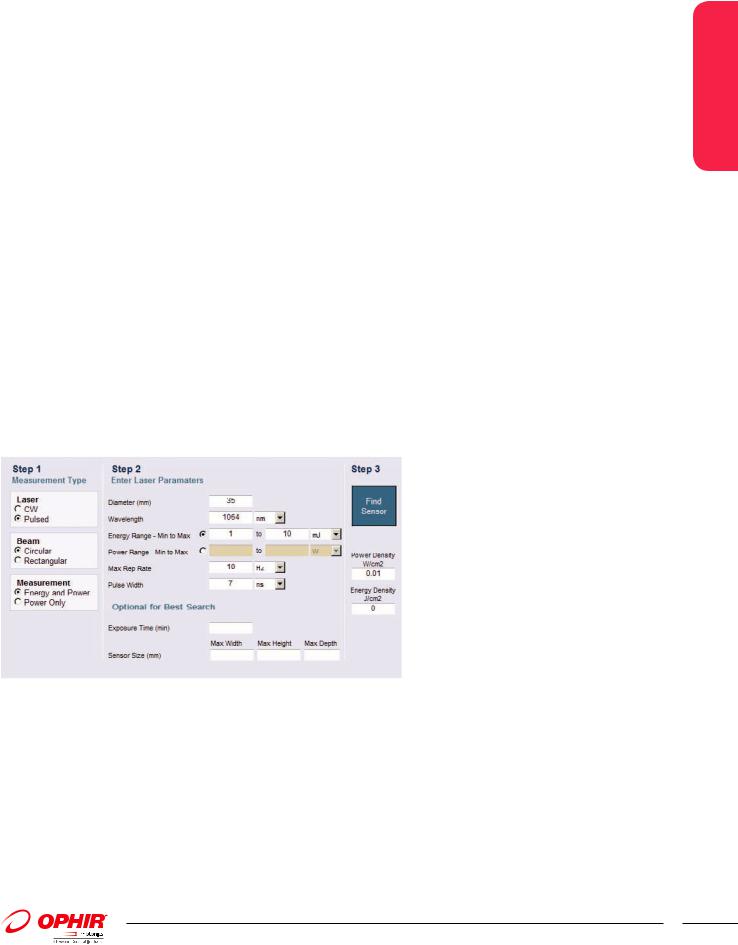
Sensor Finder Program
Finding the proper sensor(s) to meet your measurement needs has never been easier. With our sensor finder program just enter your laser parameters and the proper measuring sensors for your application will be displayed on the screen. The program calculates the power and energy density capabilities of each absorber, based on the laser wavelength, pulse length, repetition rate and other relevant parameters. It also compares all the other requirements such as maximum and minimum power, energy, beam size, etc.
In addition to finding the right sensor for your application, the Sensor Finder Program offers the following features:
ֺReport printing.
ֺHow close the recommended sensors are to the specified damage threshold.
Order of Selection
The sensors are selected in terms of cost effectiveness and ease of use, i.e. photodiode sensors and thermopiles are selected first and then pyroelectric sensors. If you want to measure only power, pyro sensors will not be selected even if they could operate within all other given laser parameters.
1.0 Sensors
Aperture
Since it is not practical to allow the beam to fill the entire aperture, the sensors are selected so that the sensor aperture is always at least 2mm or 10% larger than the beam. If the beam is rectangular its corners can touch the aperture.
Using the Sensor Finder Program
The Sensor Finder Program is available for use online at:
www.ophiropt.com/sensor-finder
It can also be downloaded for use on your own PC at:
www.ophiropt.com/sensor-finder-download
Sensor Finder Input Screen
1.When the program is started, the above screen appears: In Step 1, Select the laser type [CW or pulsed], the beam type [circular or rectangular] and whether you wish to measure both power and energy or just laser power.
2.In Step 2, Enter the required laser parameters: beam diameter, wavelength, max/min power or max/min energy, rep rate and pulse width. If minimum power is not entered, then the program assumes the minimum is ½ the maximum.
If desired, enter these optional criteria: exposure time – the maximum time the sensor measures at a time. If you only plan to measure the laser power for short periods at a time, Ophir offers more compact sensors for intermittent use.
Sensor size – only sensors smaller than the specified dimensions will be selected.
13
For latest updates please visit our website: www.ophiropt.com/photonics |
01.04.2014 |
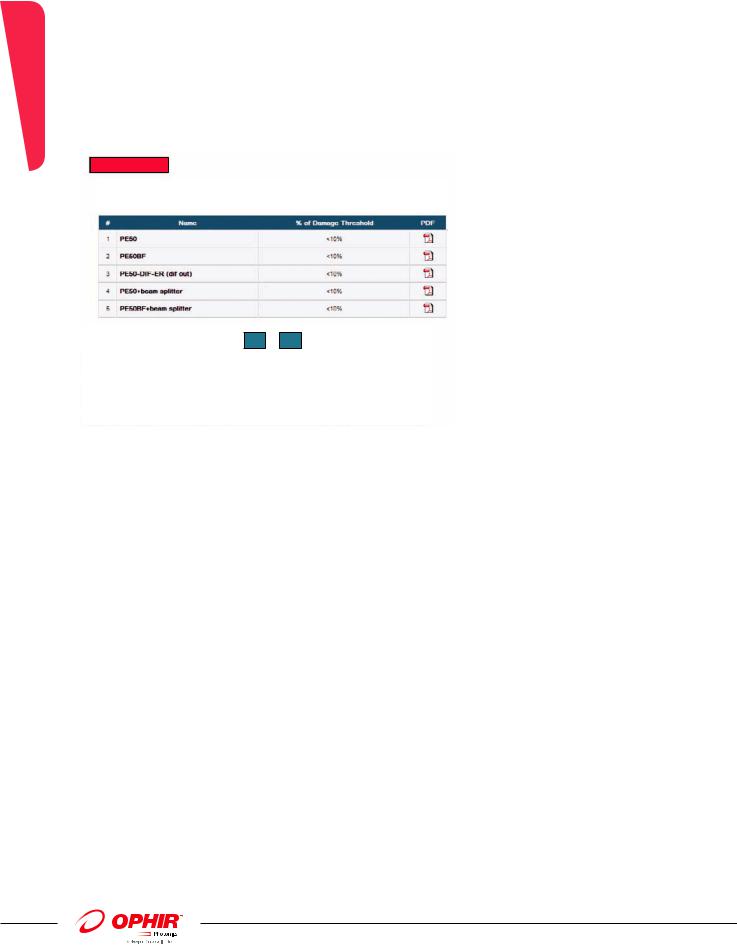
1.0 Sensors
3.In Step 3 click “Find Sensor”.
4.The sensors that meet specified criteria will be listed in the output screen shown below. The sensor type and how close to the damage threshold are listed for each result. The input parameters are listed on top.
5.In order to find compatible displays, click “Meter Finder”. In order to find compatible PC interfaces click “PC Interfaces”.
6.To save the results, click “Save”. To print the results, click “Print”.
Sensor Finder Output Screen
Another Search?
Results For:
Energy Range 1mJ to 10 mJ | Diameter 35 mm | Rep Rate 10 Hz | Wavelength 1064 nm | Pulse Width 7 ns
# |
Name |
% of Damage Threshold |
|
1 |
PE50 |
<10% |
|
|
|
|
|
2 |
PE50BF |
<10% |
|
|
|
|
|
3 |
PE50-DIF-ER (dif out) |
<10% |
|
|
|
|
|
4 |
PE50+beam splitter |
<10% |
|
|
|
|
|
5 |
PE50BF+beam splitter |
<10% |
|
|
|
|
|
Save Print
To download offline Sensor Finder version please click here
To find a meter that connects to the sensor, please click: Meter Finder.
To find PC Interfaces that connects to the sensor, please click: PC Interfaces.
For further assistance, contact us.
If sensor finder does not work properly please consult with your IT manager to reset the browser setting eg. allow javascript.
Damage Threshold
Some sensors are closer to the laser damage threshold than others. Since the damage threshold can vary somewhat from case to case and also is cumulative, the Sensor Finder Program mentions how close a particular sensor is to the damage threshold. The displayed percent of damage threshold is the highest of either the power or the energy threshold. It is recommended to select a sensor that is less than 50% of the damage threshold.
Power/Energy Meters
In order to find power/energy meters or PC interfaces that are compatible with various sensors, click "Meter Finder" or "PC Interfaces". Note that some of the newer sensors, such as the Pyro-C line sensors are only compatible with the newer meters and PC interfaces.
14
01.04.2014 |
|
For latest updates please visit our website: www.ophiropt.com/photonics |
|
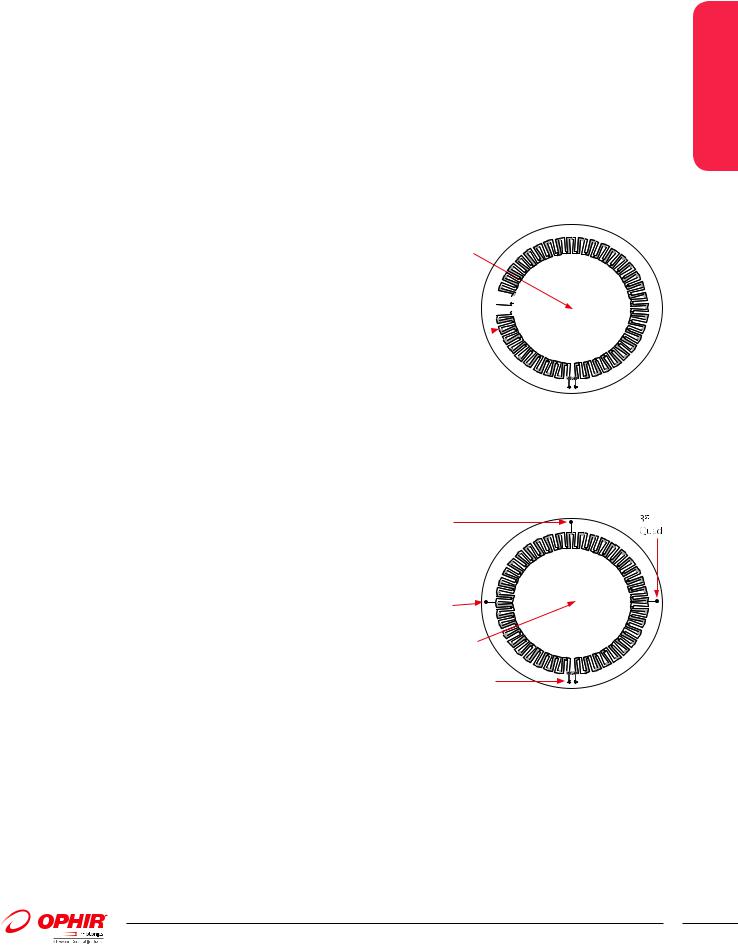
General Introduction
Types of Power/Energy Sensors
Power and Single Shot Energy Sensors
Ophir provides two types of power sensors: Photodiode sensors and Thermal sensors. Photodiode sensors are used for low powers from picowatts up to hundreds of milliwatts and as high as 3W. Thermal sensors are for use from fractions of a milliwatt up to thousands of watts. Thermal sensors can also measure single shot energy at pulse rates not exceeding one pulse every ~5s.
Repetitive Pulse Energy Sensors
For higher pulse rates, Ophir has pyroelectric energy sensors able to measure pulse rates up to tens of kHz. These are described in the energy sensor section, section 1.2.
Thermal Sensors
The thermopile sensor has a series of bimetallic junctions. A temperature difference between any two junctions causes a voltage to be formed between the two junctions. Since the junctions are in series and the «hot» junctions are always on the inner, hotter side, and the «cold» junctions are on the outer, cooler side, radial heat flow on the disc causes a voltage proportional to the power input. Laser power impinges on the center of the thermopile sensor disc (on the reverse side of the thermopile), flows radically and is cooled on the periphery. The array of thermocouples measures the temperature gradient, which is proportional to the incident or absorbed power. In principle, the reading is not dependent on the ambient temperature since only the temperature difference affects the voltage generated and the voltage difference depends only on the heat flow, not on the
ambient temperature. Since all the heat absorbed flows through the thermocouples (as long as the laser beam is inside the inner circle of hot junctions), the response of the detector is almost independent of beam size and position. If the beam is close to the edge of the inner circle, some thermocouples become hotter than others but since the sum of all of them
is measured, the reading remains the same. Generally, Ophir specifies ±2% uniformity of reading over the surface or better.
Laser impinges here
Hot 
 junction
junction 
Cold  junction
junction
Output 
BeamTrack Power / Position / Size sensors
Ophir now has the new BeamTrack thermal sensor that can measure beam position and beam size as well as power. This innovative device provides an additional wealth of
information on your laser beam – centering, beam position and wander, beam size as well as power and single shot energy. The BeamTrack sensor is illustrated schematically here and works as follows: the signal coming from the sensor is now divided into 4 quadrants so by measuring and comparing the output from the 4 sections we can determine the position of the center of the beam to a high degree of accuracy. In addition to the 4 quadrants, there is now a special proprietary beam size detector. After processing outputs from these various detectors, the user is presented with the beam position as well as beam size. Note that the beam size is calibrated only for a Gaussian beam of >3mm but for other beams it will give relative size information and will indicate if the beam is changing size. For more information on the BeamTrack sensors, please see section 1.1.3
2nd
Quad
1st
Quad
Beam size detector
4th Quad Total output
1.0 Sensors
Using Power Sensors to Measure Single Shot Energy
Although Ophir thermal power sensors are used primarily to measure power, they can measure single shot energy as well where they integrate the power over time flowing through the disc and thus measure energy. Since the typical time it takes for the disc to heat up and cool down is several seconds, these thermal sensors can only measure one pulse every several seconds at most. Thus they are suitable for what is called “single shot” measurement. Although the response time of the sensor discs is slow, there is no limit to how short the pulses measured are since the measurement is of the heat flowing through the disc after the pulse.
15
For latest updates please visit our website: www.ophiropt.com/photonics |
01.04.2014 |
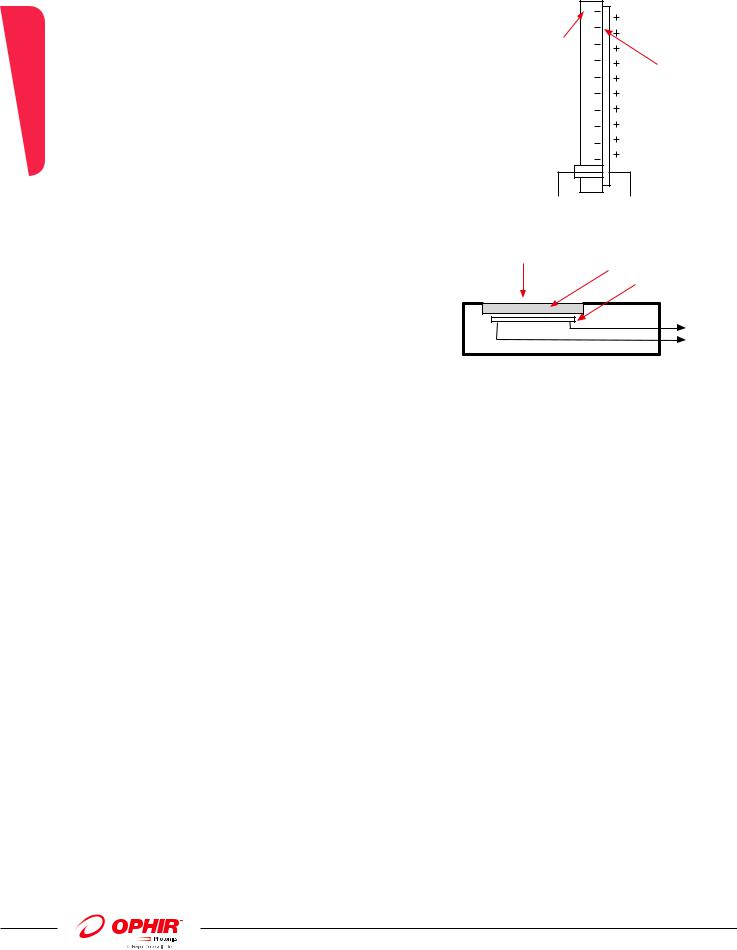
1.0 Sensors
Pyroelectric Sensors
Pyroelectric type sensors are useful for measuring the energy of repetitively pulsed lasers at up to 25,000Hz and are sensitive to low energies.
They are less durable than thermal types and therefore should not be used Heat sink disc whenever it is not necessary to measure the energy of each pulse and average
power measurement is sufficient.
Pyroelectric sensors use a pyroelectric crystal that generates an electric charge proportional to the heat absorbed. Since the two surfaces of the crystal are metalized, the total charge generated is collected and therefore the response is not dependent on beam size or position. This charge then charges a capacitor in parallel with the crystal and the voltage difference thus generated is proportional to the pulse energy. After the energy is read by the electronic circuit, the charge on the crystal is discharged to be ready for the next pulse.
Pyroelectric crystal thickness < 1mm
Electrical leads
Photodiode Sensors for Lower Powers
In addition to the thermal sensors described above, Photodiode sensors are used for low powers from picowatts up to hundreds of milliwatts and as high as 3W.
A photodiode sensor is a semiconductor device that produces a current proportional to light intensity and has a high degree of linearity
over a large range of light power levels - from fractions of a nanowatt to about 2mW. Above that light level, corresponding to a current
of about 1mA, the electron density in the photodiode becomes too great and its efficiency is reduced causing saturation and a lower
reading. Most Ophir PD sensors have a built-in filter that reduces the light level on the detector and allows measurement up to 3W
without saturation.
Laser
Optical filter
Photodiode
Output |
16
01.04.2014 |
|
For latest updates please visit our website: www.ophiropt.com/photonics |
|
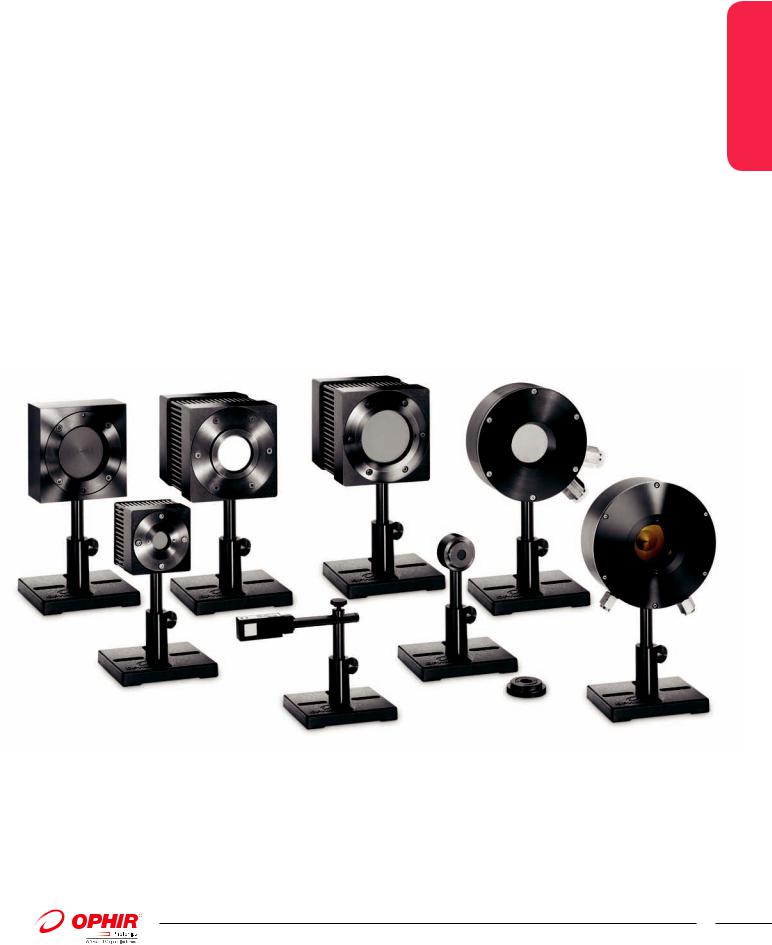
Power sensors
1.1 Sensors
17
For latest updates please visit our website: www.ophiropt.com/photonics |
01.04.2014 |
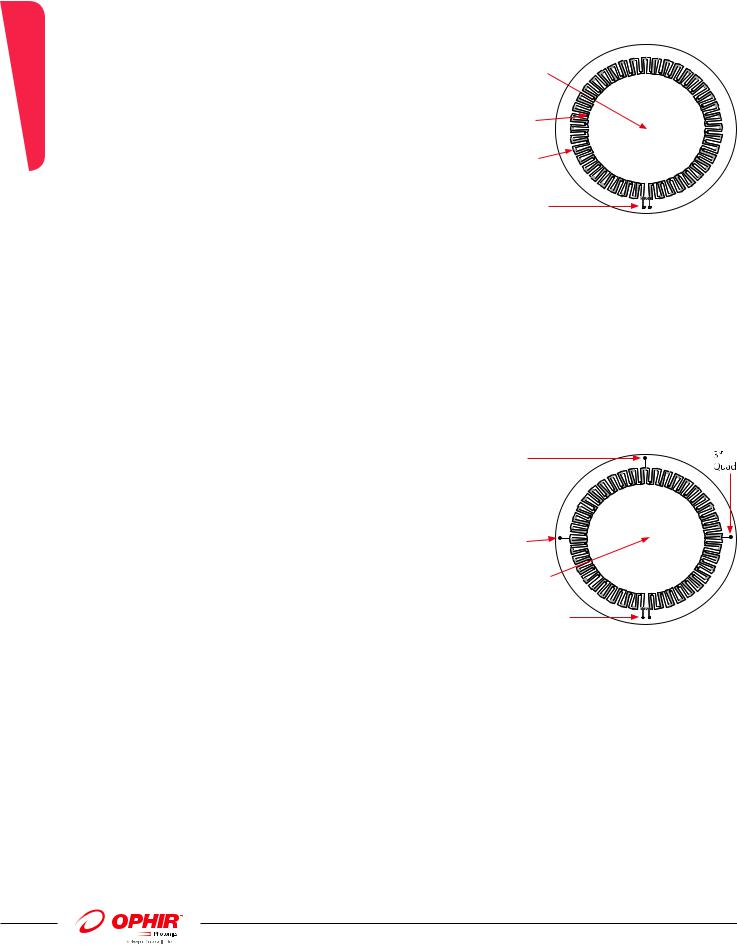
1.1 Sensors
1.1 Power Sensors
Thermal Sensors
As described in the general introduction, the thermopile sensor has a series of bimetallic
junctions. A temperature difference between any two junctions causes a voltage to
be formed between the two junctions. Since the junctions are in series and the «hot» junctions are always on the inner, hotter side, and the «cold» junctions are on the outer, cooler side, radial heat flow on the disc causes a voltage proportional to the power input. Laser power impinges on the center of the thermopile sensor disc (on the reverse side of the thermopile), flows radially and is cooled on the periphery. The array of thermocouples measures the temperature gradient, which is proportional to the incident or absorbed power. In principle, the reading is not dependent on the ambient temperature since only the temperature difference affects the voltage generated and
the voltage difference depends only on the heat flow, not on the ambient temperature.
Since all the heat absorbed flows through the thermocouples (as long as the laser beam is inside the inner circle of hot junctions), the response of the detector is almost independent of beam size and position. If the beam is close to the edge of the inner circle, some thermocouples become hotter than others but since the sum of all of them is measured, the reading remains the same. Generally, Ophir specifies ±2% uniformity of reading over the surface or better.
Using Power Sensors to Measure Single Shot Energy
Although Ophir thermal power sensors are used primarily to measure power, they can measure single shot energy as well, where they integrate the power flowing through the disc over time and thus measure energy. Since the typical time it takes for the disc to heat up and cool down is several seconds, these thermal sensors can only measure one pulse every several seconds at most. Thus they are suitable for what is called “single shot” measurement. Although the response time of the sensor discs is slow, there is no limit to how short the pulses measured are since the measurement is of the heat flowing through the disc after the pulse.
BeamTrack Power / Position / Size sensors
Ophir now has the new BeamTrack thermal sensor that can measure beam position and beam size as well as power. This innovative device provides an additional wealth of
information on your laser beam – centering, beam position and wander, beam size as well as power and single shot energy. The BeamTrack sensor is illustrated schematically here and works as follows: the signal coming from the sensor is now divided into 4 quadrants so by measuring and comparing the output from the 4 sections we can determine the position of the center of the beam to a high degree of accuracy. In addition to the 4 quadrants, there is now a special proprietary beam size detector. After processing outputs from these various detectors, the user is presented with the beam position as well as beam size. Note that the beam size is calibrated only for a Gaussian beam of >3mm but for other beams it will give relative size information and will indicate if the beam is changing size. For more information on the BeamTrack sensors, please see section 1.1.3
2nd
Quad
1st
Quad
Beam size detector
4th Quad Total output
Types of Thermopile Discs
There is no single absorber which meets the needs of all applications. Ophir has developed several types for different applications, such as long pulses (0.1-10ms), short pulses (<1µs) and continuous radiation. Absorbers optimized for long pulses and CW are characterized by thin, refractory materials, since the heat can flow through the coating and into the disc during the pulse. On the other hand, heat cannot flow during short pulses, and all the energy is deposited in a thin (typically 0.1µm) layer near the surface. This causes vaporization of the surface which ruins the absorber. Instead, a volume absorber that is partially transparent and absorbs over a distance of 50μm -3mm is used. This spreads the heat over a larger volume allowing much higher energies.
Ophir thermopiles can measure from tens of microwatts to Kilowatts. Nevertheless, the thermal range of operation of the discs is limited. If the difference between the hot and cold junction temperature exceeds tens of degrees, the constant heating/cooling of the junctions can cause premature failure in the junctions. In order to accommodate different power ranges, discs of different thicknesses and sizes are used, thick ones for high powers and thin ones for low powers.
The response time of the discs is dependent on their size and shape: larger diameters and thicker discs are slower than thin small diameter ones. The response time is in general dependent on the mass of material which has to heat up in the thin absorber region of the disc vs.
18
01.04.2014 |
|
For latest updates please visit our website: www.ophiropt.com/photonics |
|
